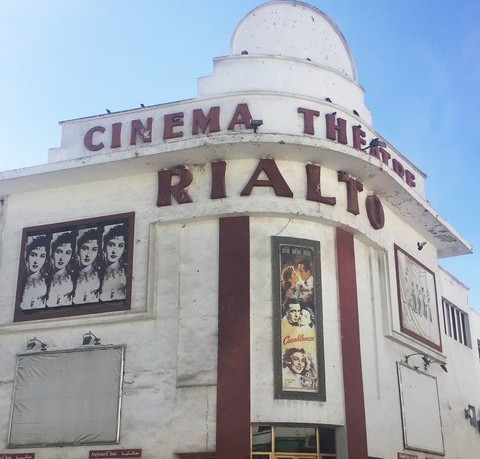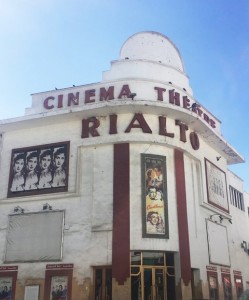Vogue
Living
Photo: Courtesy of Jen Murphy
To a romantic, Casablanca is a mythical place that exists in a dream inspired by the 1942 film starring Ingrid Bergman and Humphrey Bogart. The reality is that the movie Casablanca was actually filmed on a soundstage in Hollywood and the real Casablanca is often overlooked by tourists who gravitate to the souks of Marrakech and Fez or the exotic beaches of Essaouira and Tangier.
Casablanca is a city for travelers who like to feel like a local, rather than a tourist, and who want to experience the present as well as learn about the past. The enormity of Casablanca, Morocco’s most populous city, means visitors have to make an effort to discover its hidden details. Once you get beneath the surface, you’ll see that Casablanca’s mix of grit and style feels a lot like Los Angeles. Here’s why it’s worth a visit.
1. Casablanca is a hotbed of fascinating architecture.
Architecture buffs will geek out on the city’s diverse building styles, from Art Deco to radically modern. To truly understand the stories behind the city’s great buildings, join an architectural tour with Casamémoire, a nonprofit preservation organization working to have parts of the city designated a UNESCO World Heritage Site. The Hassan II Mosque, the largest mosque in Morocco, is a testament to incredible craftsmanship. It took more than seven years and as many as 10,000 artisans to complete the intricate masterpiece. The palm-lined Boulevard Mohammed V, in the heart of old Casablanca, is a reminder of the French influence on the city. One of the finest examples of Art Deco design, Cinéma Rialto, lies just off the main drag. Mahkama du Pacha, located in the Habous neighborhood and built in the early 1950s, is a Moroccan architecture and craftsmanship gem. Église du Sacré-Couer, a desacralized cathedral built in the ’30s, now hosts concerts and art exhibitions and is a striking mix of Gothic and Art Deco style, while Église Notre Dame de Lourdes, built in the ’50s, is a beautiful example of Brutalist architecture with stunning stained glass panels inside.
2. The city has a serious arts and culture scene.
Many of Casablanca’s historic Art Deco villas have been reborn as galleries and museums. Recently, the neon Pop Art of graffiti artist Ramzi Adek was on display at La Villa des Arts. The ’30s Art Deco villa was renovated by Casamémoire president Rachid Andaloussi and now hosts permanent and temporary exhibitions of contemporary art. A ’40s Art Deco villa on the central Rue du Parc was transformed to showcase the extensive private collection of art-loving Moroccan businessman Abderrahman Slaoui. During his travels throughout Morocco, he collected everything from Bohemian glass and vintage jewelry, all now on display in Le Musée de la FondationAbderrahman Slaoui. In 2012, the city’s old industrial slaughterhouse was reimagined as La Fabrique Culturelle des Anciens Abattoirs de Casablanca, a hub for of-the-moment street art exhibitions and urban dance and music events.
3. Casablanca is a great restaurant city.
Unlike Marrakech, Casablanca has a buzzy restaurant scene fueled by both locals and visitors. La Corniche, the city’s waterfront boulevard, lined with umbrella-shaded beach cafés, chic lounges, and ocean-view restaurants, wouldn’t seem out of place on the French Riviera. Unparalleled Atlantic views and a stylish crowd have made Le Cabestan the reservation to score on La Corniche, dating back to 1927, when the chic French restaurant first opened its doors. A 2011 renovation has kept the scene relevant, but the old standby now has competition from Bleu. Located just down La Corniche, the Four Seasons’s fifth-floor Mediterranean restaurant has become an instant hot spot thanks to its oceanfront views, outdoor terrace and fire pit, and smart nautical-inspired decor, including a striking mural of thousands of ceramic mussel shells created by Canadian design studio Moss & Lam. A raw bar showcases Dakhla oysters, prawns, and the day’s catch and diners can watch chefs cook behind a large custom grill in the center of the dining room. The barmen’s complex mocktails, infused with teas and made theatrical with dry ice, make up for the lack of booze (the restaurant’s liquor license is still pending).
After working at legendary Parisian restaurant Le Fouquet’s, Taki Kabbaj moved to Casablanca and bought Le Rouget de L’Isle. His menus of French classics pair perfectly with the restaurant’s romantic setting in an art-filled ’30s villa and its garden. La Sqala Café Maure is another of the city’s prettiest garden settings. Hidden behind the ocher walls and Majorelle blue doors of an 18th-century fortress at the edge of the old medina, Café Maure’s tranquil setting and menu of traditional Moroccan tagines and fresh juices make it a popular brunch spot. If you’re looking to splurge on a romantic meal, book a table at F.Kabbaj, a French restaurant in the Racine area specializing in locally farm-raised foie gras.
4. You can have a great meal at a tourist trap.
Tourists, particularly Americans, can’t resist dining at Rick’s Café, not because of the food, but because of the sultry atmosphere inspired by the bar made famous in the iconic film. American owner Kathy Kriger got all the details right, from the mosaic-tiled floors and arched doorways to the piano man who taps out Sinatra tunes. The culinary experience was recently elevated thanks to a collaboration with chefs from the Four Seasons: Diners who book the Taste of Placeget a private tour of the restaurant with Kriger followed by a four-course wine-paired meal that highlights the freshest local ingredients.
5. You can have a farm-to-table experience.
After years working in Miami’s nightlife business, Asmaa Benmaazouz returned home to her family farm just outside of Casablanca and turned it into a working dairy farm. La Ferme de Bousko welcomes guests for farm tours and cheese tastings. Weekend programs are perfect for families and give kids the chance to milk goats while parents learn about composting. Benmaazouz studied cheese-making in France and her cows and goats provide milk for the half-dozen cheeses she makes and sells to local restaurants and grocers. Guests are welcome to bring their own wine for a paired tasting.
6. You can practice at Morocco’s only Bikram Studio.
Tucked away in a residential section of Casablanca’s Anfa neighborhood, Om Yogais the first and only yoga studio in Morocco to offer Bikram classes. Owner Nabil Scally opened the stylish, palm-shaded space in 2013 and has expanded its offerings to include power, aerial, yin, vinyasa, and hatha yoga as well as TRX classes. His daughter, Camila Harris, is one of his top teachers and she effortlessly flows between French and English instruction. In addition to daily classes, Om offers weeklong retreats.
7. There’s a legitimate surf culture.
Casablanca’s beach scene is reminiscent of Venice Beach, a bit gritty and surf-crazed. Surf schools line La Corniche, ladies paddle out in burkinis, and each September pros from around the globe descend here to compete in the Quiksilver Pro surf competition. The neighboring little beach town of Dar Bouazza feels more like Santa Monica with its fancy houses and café-lined streets. The talented instructors from Ain Diab Surf School will take you surfing at the best breaks here. After your surf session, stop by Kai Shapes, a funky surfboard company run by an American shaper.








